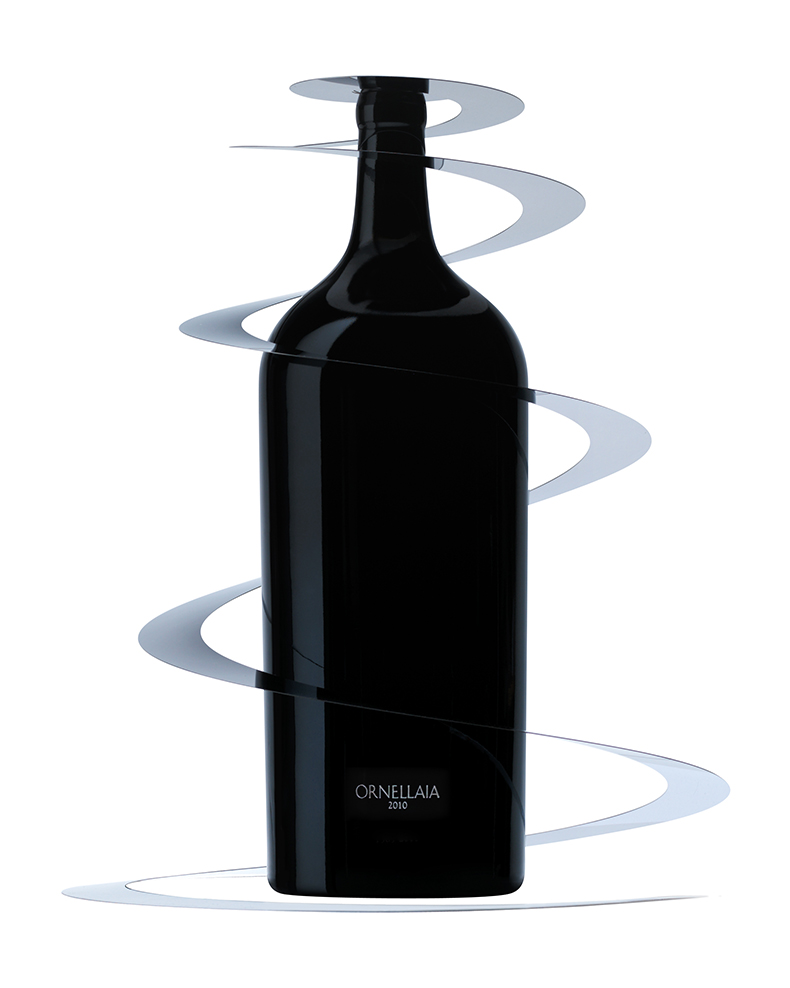From the July/August 2024 issue of Apollo. Preview and subscribe here.
‘I CONTAIN MULTITUDES,’ declares a splash of neon on an oversized wine bottle designed by the Italian artist Marinella Senatore (b. 1977). In the context of a good vintage, this is both a statement of fact about the wine and a celebration of Walt Whitman’s famous poem Song of Myself (1855). Senatore’s work is the latest commission in the Vendemmia d’Artista series from the fine wine estate of Tenuta dell’Ornellaia in Bolgheri.
Since 2006, the Tuscan estate has been inviting artists to produce a work in response to the estate’s flagship wine. Each year, the wine is assigned a ‘character’, and the artist uses this as the starting point for their work, which must include a design for a nine-litre Salmanazar bottle and a site-specific work. The commissions feature a limited-edition production of 111 large-format bottles, which are numbered and signed by the artist. Every case of Ornellaia includes one bottle with a label designed by the artist. The bottles are auctioned to support the Solomon R. Guggenheim Foundation’s Mind’s Eye programme, which helps make art and architecture more accessible for people with low vision or blindness. Through the years, the designs have transformed the bottle into an extension of a kinetic sculpture (L’Energia (2008) by Rebecca Horn), seen it wrapped in a spiral mirrored halo by Michelangelo Pistoletto for La Celebrazione (2020), and even adorned it with glass flowers sprouting from the neck in Nathalie Djurberg & Hans Berg’s Il Vigore (2019).
The nine-litre salamanzar designed by Rebecca Horn for Ornellaia’s 2008 vintage, L’Energia. © Ornellaia/Rebecca Horn

The Ornellaia estate is breaking boundaries not only with its art but also with what goes into the bottle. Ornellaia is made in the tradition of Super Tuscan wines – a loose category, perhaps even a philosophy, that emerged in the 1970s, when vintners began to break appellation rules by planting Bordeaux noble varietals such as Cabernet Sauvignon, Cabernet Franc and Merlot. Oenologists found that the muscular quality of these French varietals gave structure and oomph to the local Sangiovese, which in a subpar vintage could be limp, but was the only varietal legally permitted in Chianti. Despite the success of the wines, the Italian denomination system refused to award them any classification above Vino da Tavola, or ‘table wine’, until 1994. Even then, it was only given the label Indicazione Geografica Tipica (‘authentic geographical designation’) – two tiers down from the highest classification, Denominazione di Origine Controllata e Garantita (‘designation of controlled and guaranteed origin’).
The Marchese Lodovico Antinori, who hails from a historic negociant family, came to the region in the 1970s, purchased land next to Tenuta San Guido and, with the help of respected winemaker Tibor Gál, began planting international varietals in 1981. Four years later Antinori bottled his first Ornellaia, a blend of Cabernet Sauvignon, Merlot, Cabernet Franc and Petit Verdot, to widespread acclaim. The estate’s eminence was confirmed when the winery became part of the Frescobaldi group of wineries in 2002, held by the dynastic Florentine family that has been producing fine wines for over 700 years. Throughout its history Ornellaia has been producing bold, bright wines from a compact estate of just 99 hectares of vineyards ranging from 50m to 120m above sea level.
The nine-litre salamanzar designed by Michelangelo Pistoletto for Ornellaia’s 2010 vintage, La Celebrazione. © Ornellaia/Michelangelo Pistoletto

The Ornellaia estate’s desire to include artists in its story shows an awareness of the experiential and aesthetic qualities of wine. As Senatore says, ‘there are ingredients that are not visible in winemaking but are equally important as the materials. And this is close to any other artistic and creative language.’ For the labels, she made a series of collages that honour the care and craft of the estate workers. The figurative shapes in these collages are based on Ornellaia employees at work, vines on the estate and other features of the terroir. Senatore, a multidisciplinary artist, is used to turning her hand to new challenges. She was able to explore how ‘wine is a blend of things’. As she says, ‘The science behind it is essential, but so too is the care taken by the people involved in winemaking, as well as the sense of tradition that has been passed down the generations.’
Senatore’s artworks capture the layers of effort, meaning and emotion contained within a bottle of wine. If ever proof was needed that wine, like Whitman, contains multitudes, it can be found in the philosophy of Super Tuscan wine. While winemaking needs codification and denomination rules, there is still a role for disruption in the industry. Estate President Ferdinando Frescobaldi understands that the wines have become ‘a source of Italian pride’ and those involved in its making have a responsibility to maintain what he calls ‘the calibre of excellence’. At Ornellaia, the artists are part of this obligation too. Or as Senatore puts it, ‘in my opinion, and even more after this project, I’m convinced that wine is a modern language with which people can enter into a dialogue, just as they do with visual art’.
From the July/August 2024 issue of Apollo. Preview and subscribe here.


